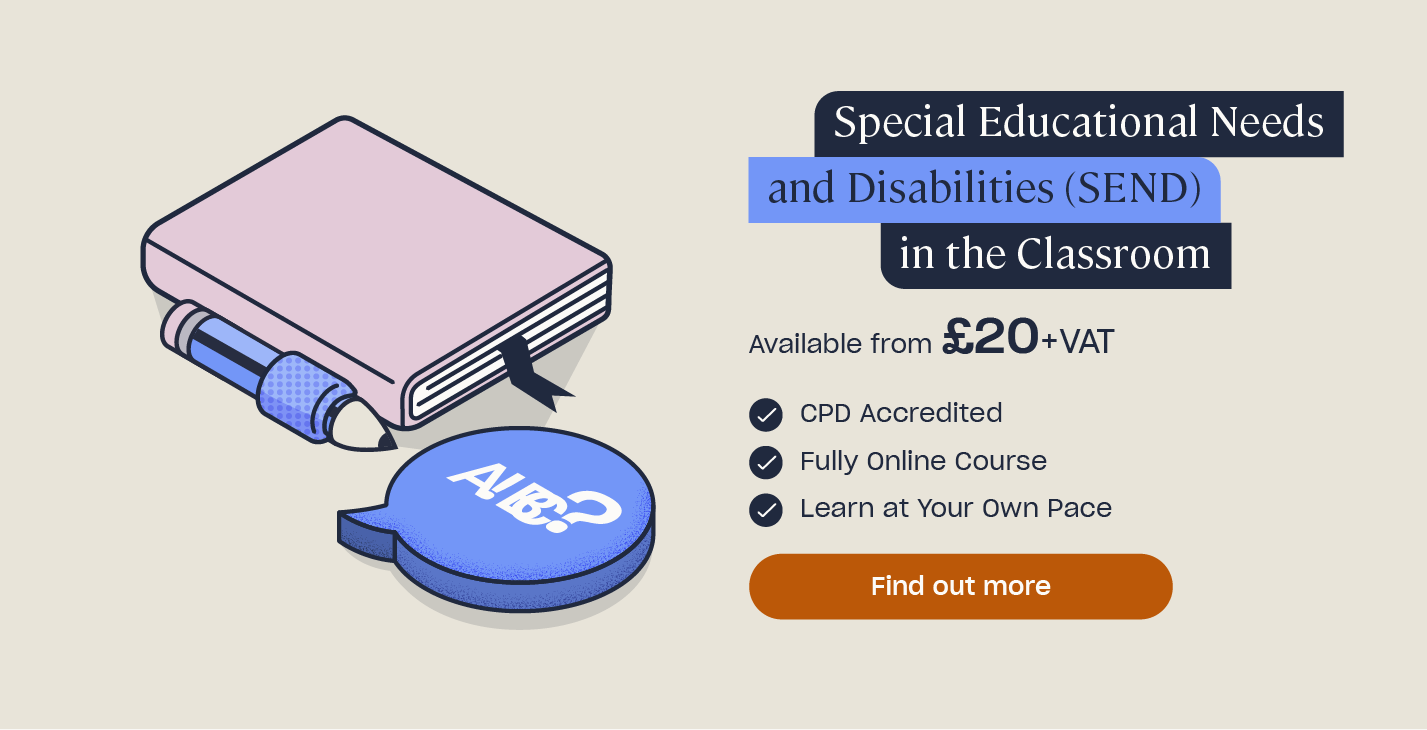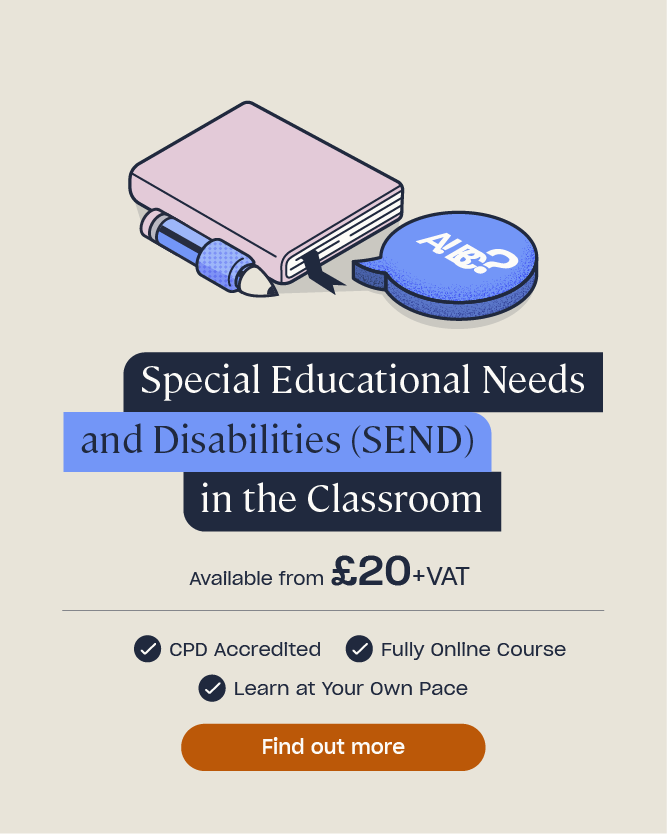Supporting Pupils with SEN in the Classroom: Guidance for Teachers
Being able to effectively support children with special educational needs (SEN) in the classroom is an essential part of any teacher’s job. Recent figures show that in a mainstream setting, you may (on average) encounter four children in every class who require support for special educational needs.
Research suggests that the behaviour and practice of the classroom teacher has the greatest impact on the academic and social outcomes of children with SEN (Efthymiou & Kington, 2017). However, whilst ultimately responsible and accountable for the progress of these children, some mainstream teachers worry that they are not effectively supporting SEN in the classroom (Warnes et al., 2021).
In this article, we aim to help increase your confidence in implementing effective teaching strategies and approaches for pupils with special educational needs.
The contents of this article are as follows:
- What Are the Different Types of Special Educational Needs?
- How Can SEN Affect a Child’s Learning in School?
- Teaching Strategies for Supporting SEN Children
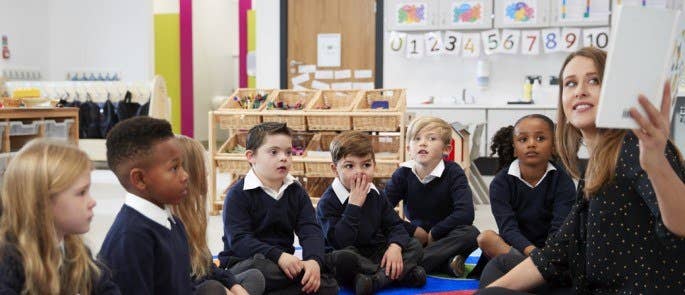
What Are the Different Types of Special Educational Needs?
Note: For the purposes of this article, we will be using the preferred person-first terminology, such as ‘supporting children with special educational needs’, rather than terms such as ‘supporting special needs children’ or ‘teaching strategies for SEN pupils’.
The SEND Code of Practice (2015) defines a child or young person as having special educational needs due to a learning difficulty or disability if he or she:
- Has a significantly greater difficulty in learning than the majority of others of the same age, or
- Has a disability which prevents or hinders him or her from making use of facilities of a kind generally provided for others of the same age in mainstream schools or mainstream post-16 institutions.
Many children and young people who have SEN may also have a disability under the Equality Act 2010. Children and young people with disabilities do not necessarily have SEN, but there is a significant overlap between children and young people with disabilities and those with SEN. This article focuses primarily on SEN.
Types of SEN
There are many types of special educational need and the SEND Code of Practice (2015) defines four broad areas of need, as follows:
- Communication and interaction.
- Cognition and learning.
- Social, emotional, and mental health difficulties.
- Sensory and/or physical needs.
If children have an Education Heath Care (EHC) plan, or personalised outcomes linked to High Needs Funding, the targets on these documents will be organised into the four broad areas of need.
The children you teach with SEN may have just one area of need or a combination. Many commonly encountered conditions will impact on more than one area.
Autism Spectrum Disorder is the most prevalent primary need stated on EHC plans for learners aged 4-17, and it would not be unusual for many autistic learners to display needs in all four main areas.
Want to Learn More About SEN?
Our SEND in the Classroom Course will teach you what you need to know to ensure you are fulfilling your legal responsibilities and following the Graduated Approach to SEND. You can also find out more about prevalent SEND in our dedicated training courses, from Autism Awareness in Education to ADHD Training.
The Communication Trust suggests that co-morbidity (children having more than one developmental difficulty) is the rule rather than the exception, and this can sometimes make categorising primary needs difficult.
Below, we list some of the most common conditions that are often associated with these four broad areas of special education needs.
Communication and Interaction
Speech, Language & Communication Needs (SLCN) is an umbrella term for a wide range of issues, and is the most prevalent need among pupils with SEN. SLCN may include:
- Problems producing sounds correctly.
- Problems understanding language.
- Problems using language.
- Problems using and understanding non-verbal communication.
- Developmental Language Disorder (DLD).
- Autism.
- Auditory Processing Disorder (APD).
- Pervasive Developmental Disorder (PDD), sometimes referred to as Pervasive Developmental Disorder – Not Otherwise Specified (PDD-NOS).
You can find out more about speech, language, and communication needs in our dedicated article here (with a focus on early years).
Cognition and Learning
Children with difficulties in this area might have:
- Specific Learning Difficulty (SpLD) which includes:
- Dyslexia – specific difficulties in literacy.
- Dyscalculia – specific difficulties in numeracy.
- Dyspraxia – specific difficulties in motor skills.
- Dysgraphia – specific difficulties in the acquisition, and recollection, of the ability to write letters and numbers.
- Moderate Learning Difficulty (MLD).
- Severe Learning Difficulty (SLD).
- Autism – although not all autistic learners will have a cognition and learning need.
Social, Emotional, and Mental Health Difficulties (SEMH)
This category can include learners with a diagnosis of any of the following:
- Emotional Behavioural Difficulties (EBD).
- Attention Deficit Disorder (ADD).
- Attention Deficit Hyperactive Disorder (ADHD).
- Obsessive Compulsive Disorder (OCD).
- Oppositional Defiant Disorder (ODD).
- Attachment disorder.
- Anxiety disorders.
- Autism, including those with a Pathological Demand Avoidance (PDA) profile.
Sensory and/or Physical Needs
This area of difficulty can include children with:
- Hearing Impairment (HI).
- Visual Impairment (VI).
- Multi-Sensory Impairment (MSI) – a combination of both hearing and visual impairments.
- Irlen Syndrome.
- Physical Disability (PD).
- Motor skills difficulties.
- Autism.
- Sensory Processing Disorder (SPD).
- Tourette’s Syndrome.
A child may be diagnosed with developmental delay in any of these areas. General Developmental Delay would usually involve difficulties in all the areas.
Whilst these areas help to categorise some of the needs, and can point you in the right direction with regards to possible strategies and interventions, each learner’s areas of strength and need are different.
Back to TopHow Can SEN Affect a Child’s Learning in School?
Just as each child’s needs are different, the impact of those needs whilst learning can vary. Children can experience both academic and social barriers due to their SEN, meaning that they are unable to reach their personal potential.
Without proper support or accommodations in place, those barriers could manifest in anxiety, disengagement, and frustration, sometimes resulting in challenging behaviours within school.

These could include:
- Withdrawn behaviours, including expressing anxiety, school phobia, truancy, and social isolation.
- Disruptive behaviours, such as calling out in class, angry outbursts, swearing, screaming, or refusing to follow instructions.
- Violent and/or unsafe behaviours such as physically harming themselves or others, running away, and damaging property.
Need Challenging Behaviour Training?
If you’re finding it difficult to handle challenging behaviour in your setting, our Challenging Behaviour course provides you with the knowledge and strategies you need to respond appropriately. Take a look at our course library for more information about our range of training available.
By effectively supporting SEN in the classroom through tailoring your learning environment and teaching practice to best meet their needs, you can help to ensure that these barriers are reduced.
A child’s area of need may change throughout their school journey. Some children’s levels of need (especially those with a diagnosed condition) will mean that they have special educational needs for their entire school career. Others may have fluctuating or isolated needs. For example, an intervention to improve gross motor skills in the early years could lead to issues being successfully addressed, bringing skills back in line with age expectations.
Back to TopTeaching Strategies for Supporting Children with SEN
Some of the ways of supporting SEN in the classroom will simply be an extension of your general good practice in the classroom, whilst other, more specific strategies may be particularly useful in supporting particular needs.
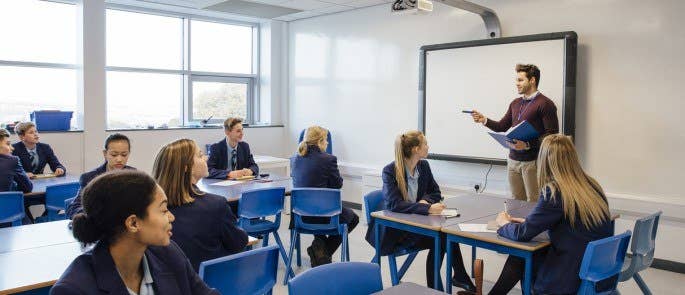
Once a child is identified as having a special educational need then it is likely you will receive, via your Special Educational Needs Coordinator (SENCo), details of some recommended strategies or interventions that you will then need to factor into your everyday planning and classroom management.
There will also be occasions, often earlier in a child’s school career, where you may suspect that child has some difficulties or additional needs, and become involved in the process of trying to pinpoint what they might be, or whether any underlying conditions are present.
In these cases, it is advisable to use your professional judgement and to begin to put some strategies in place for supporting SEN in the classroom, in consultation with your SENCo, even before any formal identification of the need.
In March 2020, The Education Endowment Fund (EEF) published a guidance report on Special Educational Needs in Mainstream Schools, highlighting best practice.
The following sections illustrate some teaching strategies that may be beneficial in meeting the needs of pupils with SEN. These are followed by some further practical tips to consider implementing in your setting.
1. Creating a Positive and Supportive Environment for All Pupils, Without Exception
A positive and supportive environment for all pupils should be underpinned by whole-school policies, practices, and culture – such as maintaining a consistent and positive approach to behaviour.
Additionally, you could use the following strategies in your classroom to reinforce this:

Actively Promoting Pupil Wellbeing
This includes explicit teaching around wellbeing and mental health (as per the statutory health curriculum requirements). You should also communicate with and respond to pupils in a manner which promotes their wellbeing at all times.
Additional practical strategies, such as introducing a class feelings board as part of the class’ daily routine, can have many benefits. Here, pupils can indicate their emotions by attaching their name or photograph to a class chart that is divided into different feelings.
This helps all children consider and express their emotions in a visual way, but especially benefits children with SEMH needs or SLCN. It gives an indication to adults working with them of how they are feeling today, which in turn allows you and your team to adapt your practice (e.g. you might decide to start with a movement break if you have a full ‘tired’ board one morning) or take time to follow up with the individual child. This strategy can also be useful in terms of safeguarding, as over time it can build a picture and allow you to see patterns. For detailed training on children’s and young people’s mental health, click here.
Positive Relationships
Prioritising, modelling, and encouraging positive relationships has also been shown to be a valuable strategy in supporting children with SEN. Many children with SEN, especially autistic children, report higher incidences of bullying (Rowley et al., 2012), so facilitating positive attitudes to difference – and supporting those children with social difficulties to maintain positive friendships – is extremely valuable.

An inclusive school environment has been shown to have a positive effect not only on those with special educational needs, but also those without.
2. Building an Ongoing, Holistic Understanding of Pupils and Their Needs
Each child’s needs are different and you will know that what works for one child will not necessarily help a child with a similar diagnosed need.
There are some conditions that may appear to present differently in the classroom between the sexes, such as autism and ADHD, and may necessitate different approaches in terms of support. For more information on how these conditions may present differently in females, visit our dedicated articles, Autism in Females: Is it Different? and How Does ADHD Differ in Females?.
By getting to know the particular needs of the individual child, you will be able to put in place personalised strategies and interventions to support them.
Communicating with Colleagues and Parents
When working with a child with SEN, knowledge-sharing and keeping lines of communication open helps you to support the child in the most effective way, building on previous successes, and responding to changes.
Your SENCo should provide you with detailed information regarding the child’s area of need and agreed outcomes, and copies of any reports and recommendations from other specialists and professionals who may be involved with the child.
Information and observations shared between colleagues are vital in producing a rounded view of the child’s needs and progress. Prior to working with the individual, you should seek information from previous teachers and teaching assistants, both to learn what has been effective and to ensure continuity of approach (for some autistic children or those with anxiety disorders, this continuity – especially at times of transition – is extremely important.)
Creating and maintaining open and honest lines of communication with parents of children with SEN will also help you to develop a more holistic understanding of the child, their strengths, and their difficulties. There is also a statutory duty to communicate with parents of children with SEN at intervals to report on progress, and to discuss future outcomes and targets.
However, some of the most valuable communication comes in more regular, less formal contact. A home-school contact book or diary can be a simple method of establishing a two-way routine of information sharing with parents.

Talking to the Child
The most important source of information that should be consulted continuously is the child or young person themselves. It is a statutory requirement that the views and wishes of the young person are taken into account when decisions are made regarding SEN provision, and that they are involved in the decision-making process as much as possible.
They can often tell you where their perceived difficulties are, and evaluate how effective the measures put in place to support them are. For example, it is counter-productive to give a fiddle toy to a child with ADHD if they personally feel singled out by it and perceive this as negative – this will not help to promote focus or reduce anxiety, so it’s important to know how they feel about it.
Using a child’s personal interests can also be a powerful tool to foster engagement and is particularly recommended in the case of autistic children. These special interests can be incorporated into learning activities or help you to create personalised reward systems.
3. Continual Evaluation
As you will know, something that proves successful one term might not have the same impact the next. Indeed, what works for a child in the morning might not have the same impact in the afternoon.

As part of the SEND Code of Practice, the government proposes an Assess, Plan, Do, Review cycle of evaluation and adaptation, which can work on a smaller, more regular scale in your classroom.
Your school will most likely have guidelines on how often you need to review SEN outcomes, interventions, or provision plans. By continually reflecting on the effectiveness of what has been put in place, and making adjustments in light of that, you can ensure you are providing the most effective support at that time.
For example, if a child has been allocated the same phonics intervention to support literacy difficulties for some time and is not making the expected progress, then it is probably time to change the approach.
The principles of continued evaluation also apply to your own confidence in supporting pupils with SEN. You may encounter a need or condition which you wish to explore in more depth, or might wish to learn more about a specific intervention. In this case, you should request the opportunity for any specific training you feel would help.

4. Ensuring All Pupils Have Access to High-Quality Teaching
Certain teaching strategies, which will already be part of your general practice, will benefit all pupils (including those with SEN) if they are used flexibly and you take into account their needs, making accommodations or introducing scaffolds as required.
When planning lessons:
- Ensure tasks are effectively differentiated and ambitious in their outcomes for all students. Organise work for learners with SEN in smaller chunks with plenty of opportunities for revisiting and over learning, where appropriate. This might involve smaller follow-up tasks.
- Use technology where appropriate to scaffold the learner. This may include equipment, apps, or specialist software such as Clicker, which can effectively support SEN.
- Deploy other adults in the classroom to effectively facilitate learning.
- Incorporate flexible grouping – do not always group children with similar SEN together; allow them to learn from their peers.
- Plan in the use of talk partners – this gives children with SEN access to peer support and the ability to rehearse their responses.
One of the most powerful tools at your disposal to help support learners with SEN is your own communication. SLCN make up the greatest proportion of special educational needs in mainstream schools, so adapting your communication (both spoken and written) can go a long way to supporting those with difficulties.
Some key principles include:
- Keep instructions clear and concise.
- Deliver instructions facing the children.
- Do not issue multiple instructions at once.
- Give children an opportunity to repeat instructions back to you.
- Accompany verbal instructions with visual aids (these can be symbols, images, or text – some schools, especially in the early years and primary sectors, have also introduced Makaton signs to accompany spoken language).
- Where appropriate, allocate other adults to re-word and re-frame instructions and information for those with SLCN.
- Verbalise your thought process whilst modelling activities, including strategies to remember what you need to do.
- Avoid idiomatic language – phrases such as ‘pull your socks up’ or ‘reach for the stars’.
Other ideas for improving your own communication can be found in our dedicated article here.
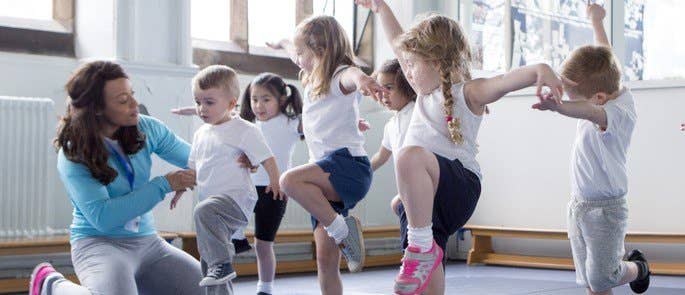
5. Complementing High-Quality Teaching with Carefully-Selected Small Group and One-to-One Interventions
You will most likely have learners in your class who need to access particular interventions in order to fulfil their potential, in addition to the high-quality whole-class teaching that you are providing.
Which Interventions Should Be Chosen?
Your SENCo will be able to advise as to which interventions would be best to meet the child’s particular needs (learners with ECH plans or High Needs Funding outcomes will often have these documented), as well as advising who best to run the intervention.
Inventions should be allocated for a pre-agreed period of time, accompanied by measurable goals, and regularly evaluated. Some schools will require teachers to produce a provision plan detailing the interventions that are taking place within the class.

When Should Interventions Take Place?
All learners have a statutory right to a broad and balanced curriculum, so care must be taken to ensure that those children with SEN are not consistently removed from lessons for interventions.
The school day is time-pressured but careful planning on your part can help to ensure that learner’s needs are met, whilst still enabling children to access the same activities as other learners. For example, always utilising assembly time for interventions would deny the child inclusion in a valuable part of school life.
Consistently removing children from wider curriculum subjects – such as art or PE – to have extra intervention on a skill they struggle with not only denies them a valuable part of the statutory curriculum, but also success at subjects they can potentially access just as well as their peers. Instead, they are made to do more of what they struggle with. This could affect self-esteem and engagement, reducing the likelihood of a successful intervention.
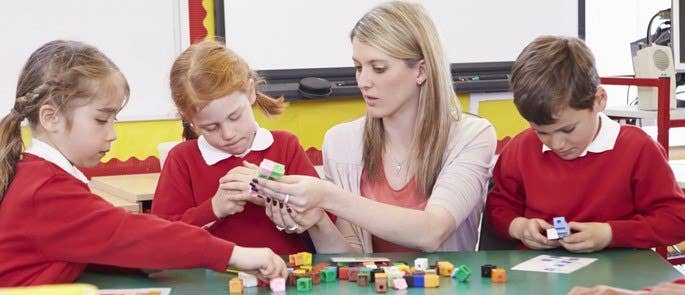
Many outcomes can be factored into allocated lesson times with personalised planning (for example, SALT objectives could be covered during adult-led discussions in literacy). Where an intervention needs to take place outside the classroom – for example, a Sensory Circuits session to support focus in a child with ADHD – these can often be factored into transition times.
There may also be particular inventions recommended for an individual with SEN that would benefit the entire class. By making it part of the whole-class routine, the child gets the benefit of the activity but is not singled out or taken out of whole-class teaching to receive it.
Good examples include strategies often recommended for pupils with ADD or ADHD, such as taking regular brain or movement breaks, or incorporating mindfulness practice into the daily routine. These generally improve the wellbeing and productivity of the entire group.
6. Working Effectively with Teaching Assistants
Teaching assistants are as essential to supporting learners with special educational needs as teachers. Many are incredibly skilled in delivering specific interventions, as well as providing excellent support within the classroom.
However, the key is to work effectively with teaching assistants, and to plan their support of learners with SEN in order to provide the highest quality support. Teaching assistants should be involved in the continual planning and evaluation process, and should be provided with the time, training, and resources necessary in order to be well-prepared for their role.
In the past, there was sometimes a tendency to support learners with SEN by simply providing them with a TA, whom they worked with almost exclusively, sometimes in place of the teacher.
Past research has shown that this is not beneficial, as it does not help to foster independence, promote inclusion, or offer agency to the learner. However, if the teachers and teaching assistants work effectively together, providing high-quality, targeted support, this can be a powerful strategy in helping to meet the needs of learners with SEN.
7. Other Strategies
The following tips are some relatively simple accommodations that could be made to help support SEN in your classroom.

Classroom Environment
Careful consideration to how your learning space is organised can significantly support learners with SEN in the classroom and remove potential barriers to success.
Think about:
- Limiting classroom decoration or displays (this can help prevent autistic children or those with sensory issues from being visually overloaded).
- Avoiding black on white presentation and varying the background colours (this can aid students with VI, dyslexia, and conditions such as Irlen Syndrome).
- Using a visual timetable throughout the day (autistic children and those with anxiety disorders can benefit from this).
- Using visuals for classroom organisation (this will help scaffold spoken instructions, benefiting children with SLCN and autistic children, whilst also providing support to younger learners and EAL learners).
- Making a work station available for learners to use when they need it (this can help support autistic learners and learners with ADHD and ODD by providing a place to access which is quiet).
Classroom Equipment
You may be able to support an individual’s special educational needs through the provision of certain equipment. Your SENCO will be able to advise with regards to these, but some examples are:
- Writing slopes (dyslexic learners and those with motor skills difficulties can be helped by these).
- Specialised pencil grips.
- Ear defenders (children with sensory issues including autistic learners can benefit from these, as can children with ADHD or ADD, helping to block out some of the background noise).
- Wobble cushions (these can help ‘ground’ learners with ADHD).
- Task management boards (these can be written, image-based, or a combination of both, and help with structure, self-organisation, and focus – particularly useful for autistic children and those with SLCN, ADD, or ADHD.
Have You Listened to our SEND Podcast?
In this episode of the High Speed Training Podcast, we are joined by Anita Devi, CEO and Founder at Team ADL, a not-for-profit committed to enabling everyone to thrive in education, employment and life. Alongside Anita is Mike Fleetham, Director and Lead Trainer at Thinking Classroom, an education mentoring organisation that has worked with over 500 schools, local authorities and organisations, and Dr Richard Anderson, Head of Learning and Development at High Speed Training. Click on the link below to access:
In summary, although there is no ‘one size fits all’ to support pupils with SEN, you can provide support to pupils with SEN in many varied ways, including: creating a positive and inclusive learning environment; consistently applying good general practice, providing high quality teaching for all; getting to know the personal needs of the individual learner; communicating honestly, openly, and regularly; carefully planning effective SEN interventions, accommodations and scaffolds; and continually evaluating your provision. We hope this article has given you some helpful suggestions for your practice.
Further Resources:
- Online Training Courses for Teaching Staff
- How to Support Children With Speech, Language, and Communication Needs
- Summary of the SEND and Alternative Provision (AP) Improvement Plan
- What is Autistic Masking?
- How Does ADHD Differ in Females?
- What are Specific Learning Difficulties (SpLDs)?
- What is the Local Offer?
- How to Use the Engagement Model in Schools
- What is SEND in Early Years?
- How to Support Children with Disabilities to be Active
- What is the Graduated Approach?
- How to Support a Child with Autism in the Classroom
- Managing ADHD in the Classroom: Teaching Strategies and Tips
- 7 Creative Classroom Exercises for Teaching SEN Children
- Special Educational Needs & Disability (SEND) Quiz
- How to Become a SEN Teacher
- SEND in the Classroom Course
- Epilepsy Awareness Training


